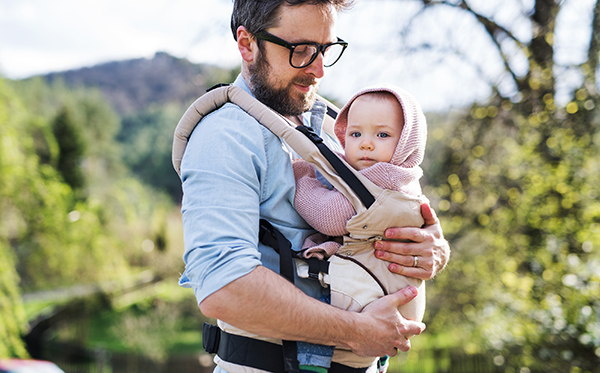As soon as your new baby is born, you think you’ll never, ever want to let this sweet bundle out of your arms.
Fast forward a couple of weeks: Your house is a mess, you need to go to the potty and you really need a snack and a drink of water—but your baby wails as soon as you lay him or her down.
Maybe it’s time to consider wearing your baby.
Baby Wearing 101
Let’s face it. Even if you’re a practiced paremt, it’s almost impossible to hold a newborn in the right position with neck support using just one arm. But mama’s got to be able to have arms free at some point—and newborns always want to be cuddled close.
Baby wearing or baby carrying involves using a soft carrier, usually a fabric sling or a more structured device with buckles so you can have the best of both worlds: You can snuggle your little one and get some things done around and outside the house at the same time.
But choosing the right wearable can be nerve-wracking—much less actually putting it on and carrying your precious new baby in it. Moms can choose from wraps, which are long pieces of scarf-like fabric that you wrap around you and your baby; mei tais, Asian-style carriers that form a pocket for the baby to rest in; soft structured carriers that buckle; or ring slings that use fabric and rings so you can loop and secure the fabric over your shoulders.
“That’s a lot of different products,” said Renee McCabe, injury prevention & SafeKids coordinator for SafeKids Greater Augusta. “What I tell moms is to follow the four Rs: research, recalls, register and read the manual.”
Research: When it comes to researching and figuring out the type of carrier that works for you, it can help to turn to your mom-friend network, borrow carriers they have, and take them for a test-drive. Or, do your research online, reading reviews and figuring out what kind of carrier you would be most comfortable with. Keep any receipts so you can return items if they don’t work for you. Also, always make sure that the carrier is designed for the age of your baby.
Recalls: If you do get a carrier secondhand, make sure to check for any recalls at www.recalls.gov. But maybe don’t pull out grandma’s ancient carrier that she used way back when. “You want to make sure you’re using a newer product since over time, manufacturers have been increasing the safety standards,” said McCabe.
Register: Once you’ve made your selection, always register your product. That way, you will be on the mailing list in case there are any recalls or safety warnings related to your carrier.
Read the manual: “You’d be surprised how many people don’t read the manual,” said McCabe. Take the time to read it and fully understand how to master the sometimes-complicated winding and folds a fabric sling can require, or exactly how to tighten the buckles and if a newborn insert is required. Then practice, practice, practice. It can take a few tries before you’re confident in safely wearing your baby for any length of time—and for your baby to get used to it too.
Finally, there are two major dangers with carriers: falls and suffocation. So whichever carrier you choose, make sure to place your baby in it while you’re above a soft surface, like a bed or sofa. Once babies are secure, make sure they can breathe, that you can see and kiss their face. “The danger is when very young babies get balled down in one of these carriers, with their chins down,” said McCabe. “That could close off their airway.”
Strolling Along
Once you’re confident, you may soon find yourself wearing your baby everywhere. (Just remember that baby wearing isn’t for the car—your child should always be in an appropriate child safety seat.)
But in certain cases, a stroller might be a better option, especially when you need help carrying bags—or even just a huge diaper bag—and plan to be doing a lot of walking.
When your baby is younger than 6 months, choose a travel system that allows you to simply snap your infant car seat right into a stroller frame. “Babies younger than 6 months don’t have the head control and shouldn’t ride upright in a more typical stroller, unless the stroller seat reclines at a 45-degre angle,” said McCabe.
You may prefer using your travel system or reclined stroller until your baby is a year old, which is perfectly fine. But beginning at 6 months or when your child has good head/neck control, you can switch to a regular stroller, with plenty of cushioning and a five-point harness.
Once your baby hits toddlerhood, you can transition to a more lightweight, easier-to-fold model—still with a five-point harness—if you choose.
“No matter what kind of carrier or stroller you choose, always read the instructions and make sure it’s age- and weight-appropriate for your baby,” said McCabe. “But remember too that carriers or even strollers aren’t for everyone. If you aren’t comfortable or just don’t want to, don’t use it. Listen to your mom instinct.”




